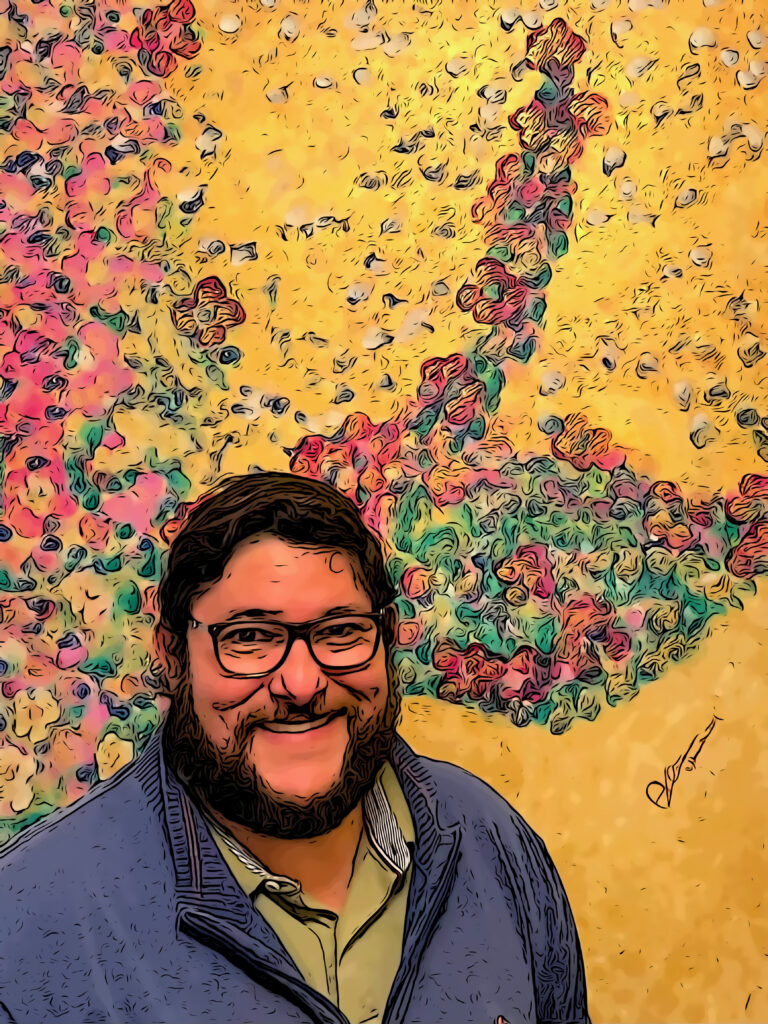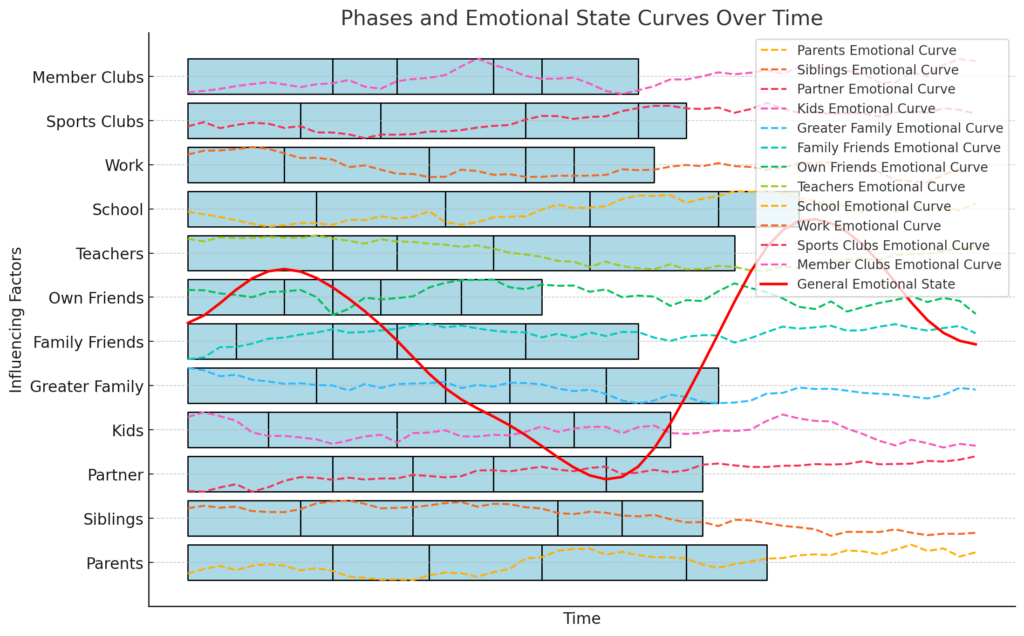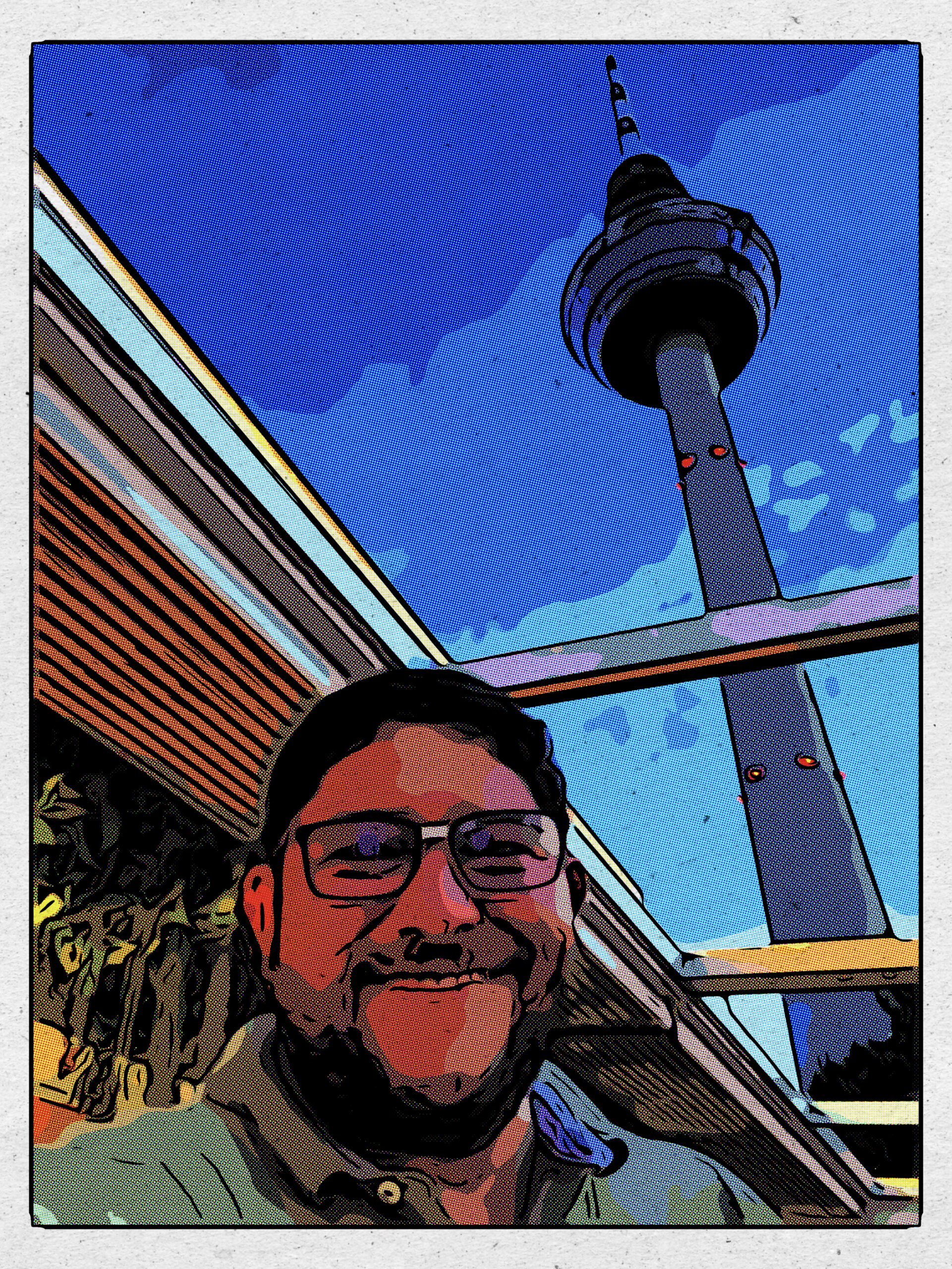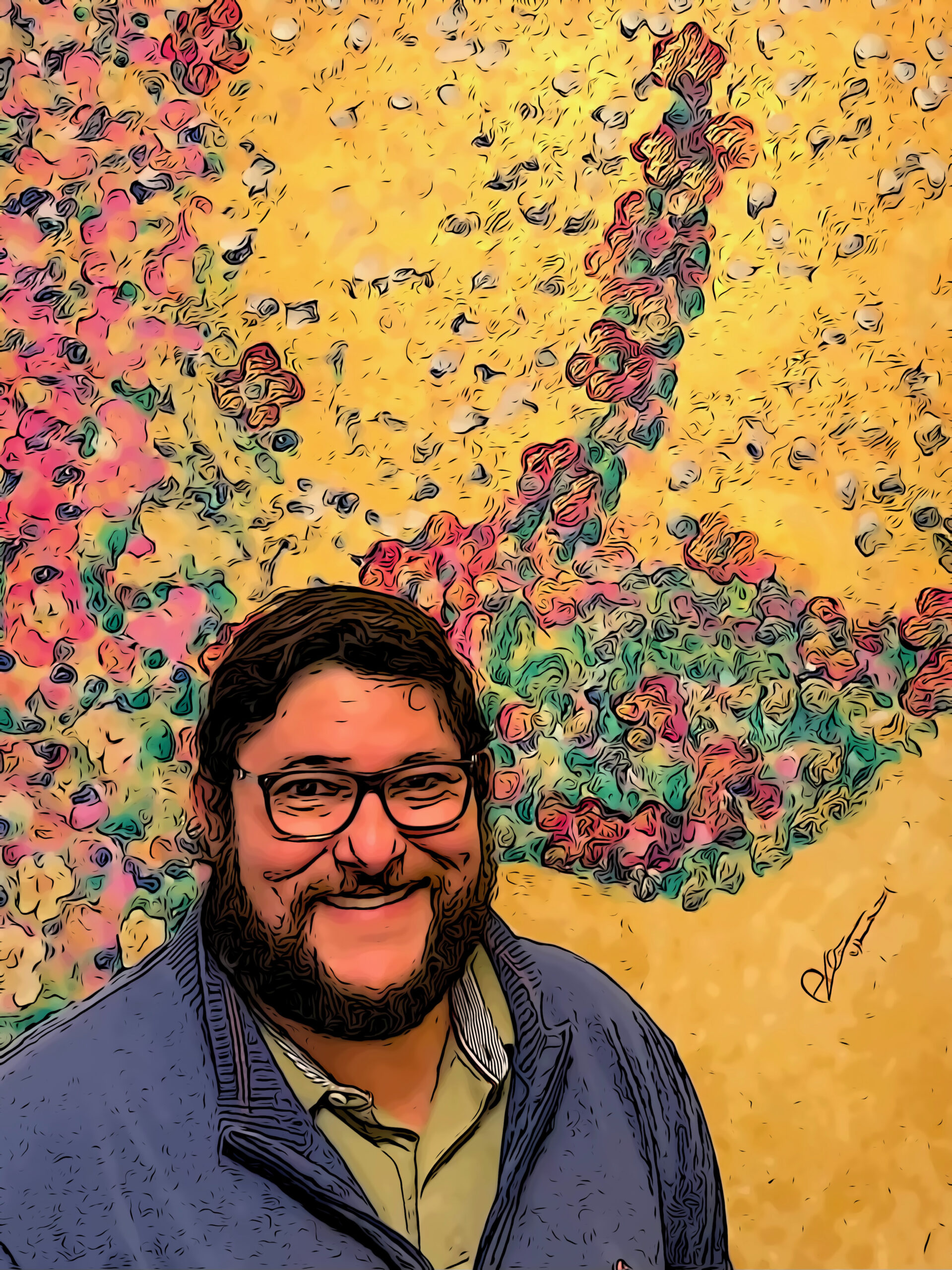In my last blog, I mentioned the Phase Model I have created. As I published through several media, I received direct messages asking me to provide more detail…so today, I want to go a bit deeper into it. Let us have a look at it.
As said in the last 2 articles, Life moves in phases! This is something I have observed, lived through, and analyzed over the years. The way we experience life, the highs and lows, the successes and struggles—they all come in phases. It was through these observations that I developed „Erich’s Phase Model“, a framework that helps us navigate the ebb and flow of life with greater clarity, resilience, and intention. The model as I am presenting it today shows the characteristics of a person, who is not a professional athlete nor an artist, as there are some specifics that apply to them, when we come to talk about the factors that influence our lives. In further articles, I will explore more of the model, specifically looking at athletes and their unique challenges.
The intention of this model is to bring to all of us a perspective that hopefully supports everyone to embrace both the difficult and the prosperous times with the right mindset. Knowing that every phase has an end, a purpose, and a unique timeframe has shaped the way I approach challenges and opportunities, and it has also shaped the way I approach my clients. In this article, I will explain the theory behind the model, the principles that define it, and how recognizing all of these can empower us to make the most of each moment.
How I define phases and my approach vs. General Human Development Stages

Phases, as I define them, are not merely stages of chronological development, such as infancy, adolescence, or adulthood. While traditional human development models focus on biological and psychological growth tied to age, for example as described in „The Developing Person Through the Life Span“ by Kathleen Stassen Berger, my model emphasizes that phases are dynamic and influenced by external circumstances, personal choices, and emotional responses rather than being strictly tied to age-related milestones.
My approach considers phases as dynamic, overlapping experiences shaped by external circumstances, personal choices, and emotional responses. They are fluid, and attached to what I call „Influencing Factors“ —parents, siblings, wife/husband/partner, kids, greater family, family friends, own friends, teachers, organizations such as schools, working places, and companies for which one works, sports clubs, member clubs — each of which has its own unique trajectory.
Unlike predefined stages of development, my model acknowledges that individuals can simultaneously experience different phases in different aspects of their lives (Influencing Factors). For instance, a person may be thriving in their career while struggling in their personal relationship with the close family. Recognizing these separate yet interconnected emotional curves helps us manage transitions more effectively, using strength in one area to support another.
When we find ourselves in a difficult phase, the awareness that this phase will eventually end gives us the strength to endure. We know that the storm will pass, and with each passing day, we are one step closer to the light at the end of the tunnel. This knowledge provides hope, grounding us in the belief that what we are going through is not permanent, and better days lie ahead. Resilience is strengthened by the certainty that life moves in phases, and that tough times will give way to more favorable periods.
Conversely, when we find ourselves in a more prosperous or peaceful phase, the conviction that this, too, will eventually end allows us to fully enjoy and appreciate the positive energy of the moment. Rather than becoming complacent, we can harness the momentum of this good phase to prepare ourselves for any challenges that may arise in the future. The awareness that all phases are transient enables us to make the most of the present while being ready for what comes next. It’s like storing up the energy and lessons of a good phase to fuel us through more challenging times ahead. Visit: „Year Endings and Beginnings – Time to Think About Phases„.
The Core Principles of Erich’s Phase Model
1. Life is defined by phases
Nothing in life remains static. We move through different experiences that shape our path and create the phases we go through. These phases are related to the Influencing Factors mentioned above. Some phases bring prosperity, while others challenge our endurance.
The way I define phases differs significantly from general human development models, which typically categorize life into rigid, linear stages. While models like Erikson’s psychosocial development or Berger’s „The Developing Person Through the Life Span“ offer a structured view of age-related growth, my model recognizes that life does not follow a universal timeline. People experience different challenges and triumphs at various times, shaped by personal choices, external influences, and their emotional landscape. This means that multiple phases can occur simultaneously in different areas of life, such as career, relationships, and personal growth (see above the Influencing Factors). By acknowledging this, we gain the flexibility to adapt and navigate life with greater awareness and intentionality.
2. Every phase has an end
It is crucial to recognize that no phase lasts forever. Just as winter eventually gives way to spring, challenging periods in our lives also transition into more favorable ones. Having this understanding creates a powerful conviction: that no matter what phase you are in, it is temporary. This conviction can have a profound impact on your ability to persevere. This knowledge provides us with strength during hardship and gratitude during ease. During positive phases, it is important to replenish the energy levels in order to compensate for those phases that are rather on a negative curve.
In „Deep Personal Change – Part 1: The Dark Side„, I described how I was caught in a downward spiral of health issues, burdened by medication and chronic pain. It felt overwhelming at times, but I reminded myself that this phase, too, would eventually pass. That awareness helped me take the necessary steps to shift into a healthier phase, reducing my medication and regaining my energy.
3. Each phase has a purpose
Even the most difficult phases carry valuable lessons. There is a learning component in each one of them. Whether we are growing, healing, or preparing for the next stage, every moment serves a purpose in our development. These phases act as turning points that challenge us to reflect, reassess, and realign our priorities. Sometimes, the purpose of a phase is not immediately clear, and it is only in hindsight that we recognize its significance. By embracing each phase with openness and curiosity, we allow ourselves to maximize our growth potential. Through self-reflection, we can extract the wisdom embedded in each phase, using it as a stepping stone toward greater resilience and self-awareness.
Consider the process of resilience-building, which I explored in „Resilience – A Tool to Transform Adversity into Growth„. Adversity is not meaningless—it is a training ground for growth. The challenges we face push us to evolve, develop new skills, and discover strengths we never knew we had. Recognizing this transforms hardship from something we suffer into something we utilize.
4. The length of a phase is not pre-determined
Some phases last weeks, others years. Unlike a calendar event, the duration of a phase is influenced by our actions, decisions, mindset, and external circumstances. Sometimes, we prolong a phase by resisting its lessons, while at other times, we transition faster by actively engaging with its challenges.
If you find yourself stuck in a difficult phase, take a moment to reflect: What is this phase trying to teach me? How can I actively engage with it instead of resisting? Embrace the changes, lean into growth, and take small, intentional steps forward. The faster we engage with our challenges, the sooner we can move towards the next phase of our journey.
Setting clear and meaningful objectives is one of the most effective ways to foster resilience. Goals provide a roadmap to guide us through difficult times, helping us focus our energy productively. However, goal-setting should be done mindfully, recognizing that prioritization is crucial. Often, we may try to tackle too much at once, but true progress comes from focusing on what matters most and learning to let go of distractions. By consciously deciding what to leave out, we create the space and clarity needed to move forward with purpose. While this process may feel uncomfortable, it is a vital part of growth. Stripping away unnecessary commitments allows us to concentrate on the actions that will bring us closer to our desired outcomes. (See: „Year Endings and Beginnings – Time to Think About Phases„).
5. Influencing Factors have their own phases, and they are all interconnected
Our personal lives, careers, relationships, and health all follow their own timelines, but they do not exist in isolation. A struggle in one area often affects another. For instance, challenges at work can create stress that impacts family relationships, while a strong support system at home can provide the resilience needed to overcome professional difficulties. Similarly, our health influences our capacity to engage fully in social and professional settings, and the presence of a supportive network of friends and family can contribute to mental well-being. Recognizing these interconnections allows us to harness positive influences in one area to strengthen another, ultimately leading to a more balanced and fulfilling life.
For instance, in „Portraits of Life Lessons – Am I a Rich Person?„, I reflected on my friend Edu’s outlook. He found wealth not in material possessions but in the richness of his relationships. This realization made me reflect on how our emotional well-being and social connections deeply influence the way we perceive and act in other aspects of life, such as our professional success and personal resilience.
6. It is easier to navigate a phase when we discover its purpose
Understanding why we are in a particular phase helps us move through it with greater ease. Instead of resisting change, we can lean into it and extract the wisdom it offers. Each Influencing Factor—such as family, work, friends, and health—has its own trajectory and emotional impact. Recognizing these unique influences allows us to harness the lessons embedded in each phase.
To enhance self-reflection and actively engage with our current phase, consider these exercises:
- Journaling Exercise: Take a few minutes daily to write about your emotions, thoughts, and events from different influencing factors in your life. Recognizing patterns in your writing can help you identify whether you are in a rising or challenging phase.
- The Perspective Shift Exercise: Choose one influencing factor where you feel stuck. Write down your perceived challenges and then reframe them by listing potential lessons or opportunities within this phase.
- The Support Network Map: Draw a visual representation of the people in your life and categorize them according to their impact on your phases (work, family, health, etc.). This will highlight who contributes positively and where you might need to seek more support.
- Mindfulness Check-ins: Set aside a moment each day to sit in stillness and ask yourself, What phase am I in right now? What is this phase trying to teach me? Deep breathing and focused awareness can make this process even more insightful.
For example, a difficult phase in career may coincide with a positive phase in personal relationships, providing a source of support and balance. Conversely, challenges in multiple areas can create a compounded effect, requiring conscious effort to maintain resilience. By actively engaging with the opportunities and lessons each Influencing Factor presents, we can navigate life’s transitions with greater adaptability and strength.
7. Emotional State Curves within the phases
Each influencing factor—family, work, friends, health—has its own emotional curve. Some may be rising while others are falling. When positive curves outweigh negative ones, they can counteract difficult emotions and phases. However, if negativity dominates, it can pull everything into a downward spiral.
To effectively manage these emotional curves, it is helpful to engage in structured self-reflection exercises. For example, regularly assess each influencing factor by rating its current emotional state on a scale of 1-10. This allows you to identify imbalances early on and take proactive steps to strengthen positive aspects. Another method is the balancing exercise, where you list aspects of life that currently provide energy and those that drain it, aiming to shift focus toward strengthening the positive influences.
Additionally, practicing gratitude by acknowledging at least three positive aspects in different influencing factors daily can significantly help in maintaining emotional equilibrium. Setting specific, small goals for each factor ensures a sense of progress, whether in career growth, deepening friendships, or improving health habits. By integrating these reflective exercises into your routine, you can better navigate emotional fluctuations and prevent negativity from overpowering your overall well-being.
This is why intrinsic motivation and positive self-talk play a key role in maintaining balance. I discuss this in „Deep Personal Change – Part 2: The Inner Fight Starts„, where I introduced the „MACARENA Mental Training“ technique. By actively reinforcing positive self-talk, we can maintain resilience even when external circumstances seem overwhelming.
8. The General Emotional State Main Curve
The general emotional state is represented by a main curve that flows along the phases defined as time frames. In positive phases, this curve trends upward, reflecting moments of confidence, joy, and stability. Conversely, during challenging phases, the curve dips, signifying periods of struggle, doubt, or stress.

A key observation in this model is that negative “Influencing Factor Emotional State Curves” tend to draw energy from positive ones. If the influencing factors that are experiencing a positive curve are not strong enough to counterbalance the negative ones, the overall emotional state can decline. Without intrinsic motivation and proactive thought patterns to counteract these declines, negativity can spiral downward, potentially leading to burnout, depression, or stagnation.
To prevent such spirals, individuals should actively reinforce positive influences and introduce resilience-building habits. This includes seeking support from strong relationships, maintaining a growth-oriented mindset, and fostering self-care routines. If the general emotional state begins to dip, proactive adjustments—such as re-engaging in activities that provide fulfillment, practicing gratitude, or leveraging social support—can help stabilize or reverse the downward trend, ensuring a more balanced and sustainable emotional experience.
9. Fun is a catalyst for resilience
Every phase, even the difficult ones, carries opportunities for moments of fun. Yet, as we grow older, societal norms often push us toward seriousness, associating professionalism with a stern demeanor and labeling relationships as „serious,“ as though fun were incompatible with commitment. However, fun is an essential component of resilience, acting as a psychological buffer against stress and adversity.
In challenging phases, finding moments of joy can help us regain strength and maintain perspective. Laughter, playfulness, and enjoyable activities are not distractions; they are fuel for mental endurance. Fun can act as an emotional reset, breaking the cycle of stress and negativity, and giving us renewed energy to tackle difficulties.
To actively integrate fun into our lives and strengthen resilience:
- Prioritize Play: Set aside time for activities that bring joy and relaxation, such as engaging in hobbies, playing sports, or spending time with loved ones.
- Embrace Spontaneity: Be open to unplanned moments of joy. Sometimes the most meaningful experiences are the ones that surprise us.
- Create a Positive Environment: Whether at work or home, fostering a culture of humor, lightheartedness, and creativity enhances motivation and teamwork.
- Use Mindfulness to Enhance Enjoyment: Fully engage in moments of joy instead of letting them pass unnoticed. Savor small, positive experiences to counterbalance stress.
- Cultivate a Sense of Humor: Laughter is a natural stress reliever. Finding humor in everyday situations strengthens our ability to stay optimistic during difficult times.
By embedding fun into our daily lives, we create pockets of relief in stressful phases, allowing us to recharge and maintain the energy needed to persevere. Fun is not a distraction from growth—it is an integral part of long-term resilience and well-being.
Conclusion
This Phase Model provides a structured yet flexible framework for navigating life’s inevitable ups and downs. By understanding that every phase has an end, a purpose, and a unique duration, we can develop a mindset that allows us to endure difficult times while making the most of positive ones. Recognizing the interconnected nature of influencing factors helps us balance our emotional state, ensuring that negative influences do not spiral out of control.
To make the best out of each phase, it is crucial to engage proactively. When faced with challenges, take the opportunity to learn, adapt, and develop resilience. When in a prosperous phase, use the momentum to replenish your energy and build resilience for future struggles. Life’s phases are transient, and by embracing their cyclical nature, we can move forward with clarity, purpose, and strength.
An often-overlooked but crucial component of resilience is fun. Engaging in moments of joy, laughter, and play is not merely a distraction—it is a tool that strengthens our ability to cope with stress and adversity. Fun acts as an emotional reset, allowing us to recharge and maintain a sense of balance even during the most difficult phases. Whether it is through hobbies, social interactions, humor, or spontaneous activities, incorporating fun into our daily lives ensures that we can navigate life’s ups and downs with greater ease and optimism.
I invite you to reflect on your current phase and take intentional actions to optimize your personal growth. Engage in self-reflection exercises, seek support from your network, and cultivate resilience through mindful goal-setting. Most importantly, do not forget to bring fun into your journey—it is a powerful catalyst that fuels resilience and strengthens your ability to thrive in any phase of life.

Erich is an experienced life + business coach. He has a track record of over 21 years in supporting staff and leadership in organizations, athletes, and private people in their efforts to enable changes in their lives.
He knows from his own experience how to ignite the passion in people, how to let people gain new perspectives, set new objectives, and follow through completion.
As a native speaker, Erich provides coaching in German and Spanish, as well as in English thanks to his more than 3 decades of experience working at the international level.
Last posts

Eine Antwort zu “Erich´s Phase Model – The Theory Behind”
[…] introduced in previous TEZ blogs (I recommend you to read now the previous blog: “Erich’s Phase Model – The theory behind”), the Phase Model is founded on a profound truth: life unfolds in phases. These phases are not […]